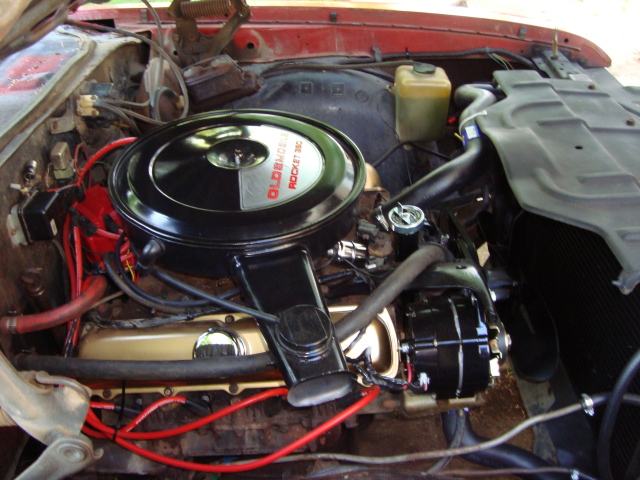Classic/Antique Car Repair: 1972 Cutlass Supreme, 1972 cutlass supreme, ohm resistor
Question Engine bay
Engine bay
QUESTION: Recently I purchased a '72 Cutlass from a private dealer in Michigan knowing full well that it was going to be a resto project. Upon receiving the car (CO. Resident) it was quite evident the car was going to need some wrench time, to include engine parts that were in need of replacement. On part in particular was the alternator, which was not only evident by its cosmetic appearance, but the generator light was illuminated on the dash. I replaced the alternator with a higher output (105 amps)GM "SI" series alternator. While installing the alternator I realized I needed a different wiring harness for the new connection requirements, and I purchased/spliced in a NAPA supplied wiring harness instead of a wiring harness adaptor kit. Question is, despite the change over, it would appear the alternator is not charging the battery as expected. I had the charging system tested and the alternator is functioning (Car battery died, was jumped, alternator got me home, but failed to start once home due to dead battery). I also replaced the regulator on the fire wall assuming that could be the problem as well. However, despite my best attempts, the battery will not stay charged even though the battery test good at local auto parts store. Your help in remedying this problem would be greatly appreciated.
ANSWER: The SI series alternator by Delco is equipped with an internal voltage regulator. When retrofitting this unit to an older GM car ignore and disconnect the external regulator. The wiring is simple. The main terminal on the back of the alternator is connected with at least a 10 gage wire to the battery. the two spade terminals are numbered, with the one on the left looking at the alternator from the back is terminal #1 and the right one is terminal #2. terminal number one is connected to the ignition switch but must have a 10 ohm resistor or a small bulb in series. If it is connected directly to the ignition it is possible to damage the diode trio in the alternator. Terminal #2 is connected directly to the battery and a 14 gage wire is ok here. This senses battery voltage to tell the internal regulator to charge more or less. Good luck.
Brad
---------- FOLLOW-UP ----------
QUESTION: How would I know if the diode trio in the alternator is bad (new alternator)? And without assuming liability where would you go from here. I basically assumed a "plug and play" if you will aside from splicing the wiring to connect to a SI model.
AnswerI would rewire the unit the correct way with a 10 ohm resistor available from radio Shack and then test the alternator output. If low output then the unit needs to come apart. the diode trio can be replaced with no problem. Let me know after you rewire and test the output.
Brad
